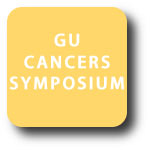ORLANDO, FL, USA (UroToday.com) - Emmanuel S. Antonarakis, MBBCh, a thought leader in androgen resistance and its biomarkers, presented the work of several groups on these topics.
He began by reviewing data from a recent M.D. Anderson publication showing that an AR signature and CYP17 staining in biopsy of bone metastases was associated with a survival benefit in abiraterone-treated patients. Presence of these markers suggests that both the drug target (CYP17) and the testosterone target (AR) are present. A similar study design was used in a separate European study in patients treated with enzalutamide and showed that co-occurrence of the same markers was associated with benefit from enzalutamide. This second study was the first to show that an AR variant 7 (ARv7; a truncated form of the receptor) is a marker of resistance to these drugs. In a third study, intrinsic resistance to enzalutamide/abiraterone combination therapy was identified in ~10% of patients. Again the CYP17/AR staining pattern predicted PSA decline, and ARv7 presence correlated with intrinsic resistance. Markers can also be used in blood based qPCR assays to detect gene amplification in circulating tumor cells (CTC). Curiously, amplification of AR or CYP17 correlated with resistance to abiraterone in contrast to the M.D. Anderson data.
 The AR splice variant field is becoming very interesting as it seems to associate with abiraterone/enzalutamide resistance as described. A recent publication by Dr. Antonarkis’ groups showed that in patients with CTCs which harbor ARv7, enzalutamide or abiraterone resistance is intrinsic. This suggests that ARv7 may be both the biomarker and the mechanism of resistance itself. ARv7 may modify full-length AR signaling through heterodimerization, behave as a dominant negative, or be constitutively active. Indeed, there is already basic research by Dr. Scott Dehm which shows that ARv7 is able to activate target genes in the absence of testosterone. Another form of AR alteration, AR point mutations, is historically a mechanism of resistance to traditional ADT. AR mutation also seems to play a role in abiraterone resistance. In a prospective study of patients on abiraterone, 3 of 16 patients had L702H mutations which caused AR to be activated by glucocorticoid, one had W742C which caused its activation by bicalutamide, and one had T878A which caused its activation by progesterone. AR-ligand promiscuity is a clinical problem but in some cases has an easy solution: withdrawal therapy and indeed this was the case. Patients with L702H mutations had a PSA response after withdrawal of therapy, suggesting that stopping prednisone rescue treatment was what caused response. Further, the T878A mutation which causes progesterone promiscuity could be amenable to withdrawal, as progesterone levels increase on abiraterone treatment because due to blockade of steroid biogenesis. Additionally, recently described but still unpublished F876L mutations can cause enzalutamide to become an agonist. They were present in 10-15% of patients on enzalutamide or ARN-509, another direct androgen receptor antagonist. Presence of these mutations correlates with the advent of resistance in patients who are serially biopsied. Lastly, androgen signaling in TMPRSS2-ERG-fusion cases have been studied, but results were mixed. However, retrospective review of COU-AA-302 showed there was no relation to response in ERG+ versus ERG- tumors in general, but in patients with 2+Edel rearrangements, there was an improvement in time to progression or death. The 2+Edel rearrangements result in duplication of the fusion of TMPRSS2 to ERG sequences, together with interstitial deletion of sequences 5' to ERG.
The AR splice variant field is becoming very interesting as it seems to associate with abiraterone/enzalutamide resistance as described. A recent publication by Dr. Antonarkis’ groups showed that in patients with CTCs which harbor ARv7, enzalutamide or abiraterone resistance is intrinsic. This suggests that ARv7 may be both the biomarker and the mechanism of resistance itself. ARv7 may modify full-length AR signaling through heterodimerization, behave as a dominant negative, or be constitutively active. Indeed, there is already basic research by Dr. Scott Dehm which shows that ARv7 is able to activate target genes in the absence of testosterone. Another form of AR alteration, AR point mutations, is historically a mechanism of resistance to traditional ADT. AR mutation also seems to play a role in abiraterone resistance. In a prospective study of patients on abiraterone, 3 of 16 patients had L702H mutations which caused AR to be activated by glucocorticoid, one had W742C which caused its activation by bicalutamide, and one had T878A which caused its activation by progesterone. AR-ligand promiscuity is a clinical problem but in some cases has an easy solution: withdrawal therapy and indeed this was the case. Patients with L702H mutations had a PSA response after withdrawal of therapy, suggesting that stopping prednisone rescue treatment was what caused response. Further, the T878A mutation which causes progesterone promiscuity could be amenable to withdrawal, as progesterone levels increase on abiraterone treatment because due to blockade of steroid biogenesis. Additionally, recently described but still unpublished F876L mutations can cause enzalutamide to become an agonist. They were present in 10-15% of patients on enzalutamide or ARN-509, another direct androgen receptor antagonist. Presence of these mutations correlates with the advent of resistance in patients who are serially biopsied. Lastly, androgen signaling in TMPRSS2-ERG-fusion cases have been studied, but results were mixed. However, retrospective review of COU-AA-302 showed there was no relation to response in ERG+ versus ERG- tumors in general, but in patients with 2+Edel rearrangements, there was an improvement in time to progression or death. The 2+Edel rearrangements result in duplication of the fusion of TMPRSS2 to ERG sequences, together with interstitial deletion of sequences 5' to ERG.
In summary, androgen resistance seems to be mediated by alterations in AR itself, and research into these alterations is needed to understand their nature.
Presented by Emmanuel S. Antonarakis, MBBCh at the 2015 Genitourinary Cancers Symposium - "Integrating Biology Into Patient-Centric Care" - February 26 - 28, 2015 - Rosen Shingle Creek - Orlando, Florida USA
Johns Hopkins Medicine, Baltimore, MD USA
Reported by Phillip Abbosh, MD, PhD, medical writer for UroToday.com

